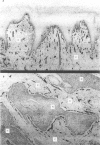Abstract
For tumours to grow they must acquire an adequate blood supply, and the use of drugs to inhibit tumour vascularization is one promising approach to anti-cancer therapy. Clear information is therefore required on the vascular architecture of human tumours and animal tumour models used for testing anti-angiogenic therapies. Many previous studies on animal tumour models have shown that carcinomas are least vascular in their centres and that host tissues become more vascular with proximity to the tumour. However, we have previously found that many human colorectal carcinomas do not show this pattern. The present study on human oral squamous cell carcinomas (SCCs) again reveals significant differences. Paraffin sections from 24 SCCs were immunostained using the QBEnd-10 monoclonal antibody to demonstrate blood vessels, and these were quantified by interactive morphometry using a Kontron Videoplan system. In most carcinomas, viable tumour tissue was no less vascular in the tumour centre than in the tumour periphery. Although tumours are known to release angiogenic factors, viable tumour tissue was less vascular than adjacent host tissues. However, the tumour stroma, by itself, was more vascular than adjacent host tissues. Host tissue adjacent to tumour showed no obvious increase in vascular density with increasing proximity to the tumour edge, which suggests that tumour-released angiogenic factors are only effective over a short distance.
Full text
PDF






Images in this article
Selected References
These references are in PubMed. This may not be the complete list of references from this article.
- Albo D., Granick M. S., Jhala N., Atkinson B., Solomon M. P. The relationship of angiogenesis to biological activity in human squamous cell carcinomas of the head and neck. Ann Plast Surg. 1994 Jun;32(6):588–594. doi: 10.1097/00000637-199406000-00005. [DOI] [PubMed] [Google Scholar]
- Brown L. F., Berse B., Jackman R. W., Tognazzi K., Guidi A. J., Dvorak H. F., Senger D. R., Connolly J. L., Schnitt S. J. Expression of vascular permeability factor (vascular endothelial growth factor) and its receptors in breast cancer. Hum Pathol. 1995 Jan;26(1):86–91. doi: 10.1016/0046-8177(95)90119-1. [DOI] [PubMed] [Google Scholar]
- Carnochan P., Briggs J. C., Westbury G., Davies A. J. The vascularity of cutaneous melanoma: a quantitative histological study of lesions 0.85-1.25 mm in thickness. Br J Cancer. 1991 Jul;64(1):102–107. doi: 10.1038/bjc.1991.250. [DOI] [PMC free article] [PubMed] [Google Scholar]
- Folkman J. Tumor angiogenesis. Adv Cancer Res. 1985;43:175–203. doi: 10.1016/s0065-230x(08)60946-x. [DOI] [PubMed] [Google Scholar]
- Gabbert H., Wagner R., Höhn P. The relation between tumor cell proliferation and vascularization in differentiated and undifferentiated colon carcinomas in the rat. Virchows Arch B Cell Pathol Incl Mol Pathol. 1982;41(1-2):119–131. doi: 10.1007/BF02890276. [DOI] [PubMed] [Google Scholar]
- Goepfert H. Are we making any progress? Arch Otolaryngol. 1984 Sep;110(9):562–563. doi: 10.1001/archotol.1984.00800350004002. [DOI] [PubMed] [Google Scholar]
- Guidi A. J., Abu-Jawdeh G., Berse B., Jackman R. W., Tognazzi K., Dvorak H. F., Brown L. F. Vascular permeability factor (vascular endothelial growth factor) expression and angiogenesis in cervical neoplasia. J Natl Cancer Inst. 1995 Aug 16;87(16):1237–1245. doi: 10.1093/jnci/87.16.1237. [DOI] [PubMed] [Google Scholar]
- Hawkins M. J. Clinical trials of antiangiogenic agents. Curr Opin Oncol. 1995 Jan;7(1):90–93. [PubMed] [Google Scholar]
- Hewitt R. E., Powe D. G., Carter G. I., Turner D. R., Price J. E. Basement membrane collagen-IV synthesis in colorectal tumours. Int J Cancer. 1992 Jun 19;51(4):530–536. doi: 10.1002/ijc.2910510405. [DOI] [PubMed] [Google Scholar]
- Hsu S. M., Raine L., Fanger H. The use of antiavidin antibody and avidin-biotin-peroxidase complex in immunoperoxidase technics. Am J Clin Pathol. 1981 Jun;75(6):816–821. doi: 10.1093/ajcp/75.6.816. [DOI] [PubMed] [Google Scholar]
- Kumagai H. [Recent progress in the development of anti-tumor metastatic drugs]. Gan To Kagaku Ryoho. 1995 Apr;22(5):585–591. [PubMed] [Google Scholar]
- Penfold C. N., Partridge M., Rojas R., Langdon J. D. The role of angiogenesis in the spread of oral squamous cell carcinoma. Br J Oral Maxillofac Surg. 1996 Feb;34(1):37–41. doi: 10.1016/s0266-4356(96)90133-3. [DOI] [PubMed] [Google Scholar]
- Pritchard A. J., Chatterjee T., Wilkinson M., Powe D. G., Gray T., Hewitt R. E. Evidence for a weak angiogenic response to human colorectal cancers. Br J Cancer. 1995 May;71(5):1081–1086. doi: 10.1038/bjc.1995.209. [DOI] [PMC free article] [PubMed] [Google Scholar]
- Rak J. W., St Croix B. D., Kerbel R. S. Consequences of angiogenesis for tumor progression, metastasis and cancer therapy. Anticancer Drugs. 1995 Feb;6(1):3–18. doi: 10.1097/00001813-199502000-00001. [DOI] [PubMed] [Google Scholar]
- Ramani P., Bradley N. J., Fletcher C. D. QBEND/10, a new monoclonal antibody to endothelium: assessment of its diagnostic utility in paraffin sections. Histopathology. 1990 Sep;17(3):237–242. doi: 10.1111/j.1365-2559.1990.tb00713.x. [DOI] [PubMed] [Google Scholar]
- Srivastava A., Laidler P., Davies R. P., Horgan K., Hughes L. E. The prognostic significance of tumor vascularity in intermediate-thickness (0.76-4.0 mm thick) skin melanoma. A quantitative histologic study. Am J Pathol. 1988 Nov;133(2):419–423. [PMC free article] [PubMed] [Google Scholar]
- Thompson W. D., Shiach K. J., Fraser R. A., McIntosh L. C., Simpson J. G. Tumours acquire their vasculature by vessel incorporation, not vessel ingrowth. J Pathol. 1987 Apr;151(4):323–332. doi: 10.1002/path.1711510413. [DOI] [PubMed] [Google Scholar]
- Vikram B., Strong E. W., Shah J. P., Spiro R. Failure at distant sites following multimodality treatment for advanced head and neck cancer. Head Neck Surg. 1984 Jan-Feb;6(3):730–733. doi: 10.1002/hed.2890060305. [DOI] [PubMed] [Google Scholar]
- Vile R. Cancer therapy. Less blood means more sanguinity. Curr Biol. 1995 Jan 1;5(1):10–13. doi: 10.1016/s0960-9822(95)00004-2. [DOI] [PubMed] [Google Scholar]
- Weidner N., Folkman J., Pozza F., Bevilacqua P., Allred E. N., Moore D. H., Meli S., Gasparini G. Tumor angiogenesis: a new significant and independent prognostic indicator in early-stage breast carcinoma. J Natl Cancer Inst. 1992 Dec 16;84(24):1875–1887. doi: 10.1093/jnci/84.24.1875. [DOI] [PubMed] [Google Scholar]
- Weidner N., Semple J. P., Welch W. R., Folkman J. Tumor angiogenesis and metastasis--correlation in invasive breast carcinoma. N Engl J Med. 1991 Jan 3;324(1):1–8. doi: 10.1056/NEJM199101033240101. [DOI] [PubMed] [Google Scholar]
- Woolgar J. A., Scott J., Vaughan E. D., Brown J. S., West C. R., Rogers S. Survival, metastasis and recurrence of oral cancer in relation to pathological features. Ann R Coll Surg Engl. 1995 Sep;77(5):325–331. [PMC free article] [PubMed] [Google Scholar]




